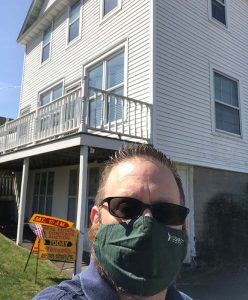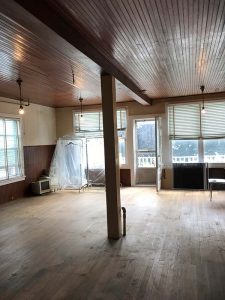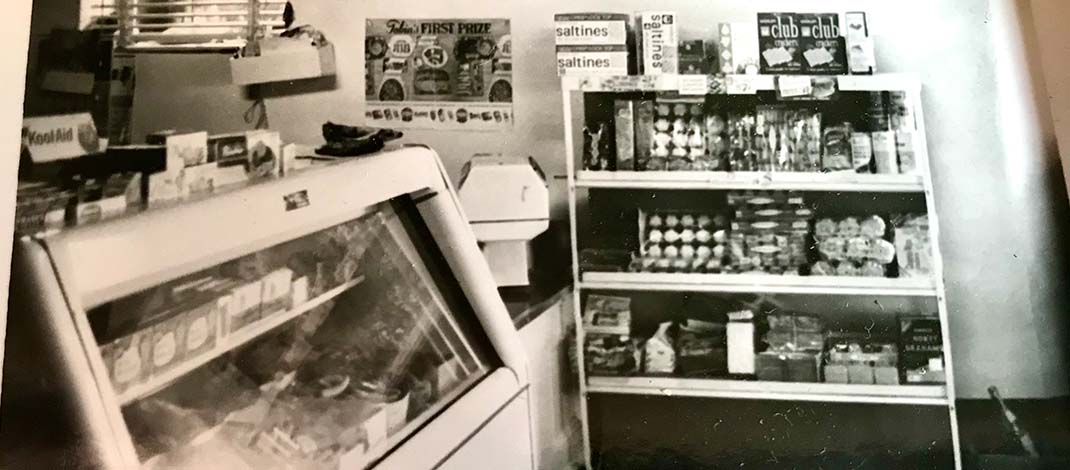Buying a House to Help Preserve a Neighborhood and Heritage
Sometimes you go to an auction and buy a historic house that was a cornerstone of your neighborhood.
Not often, but it happened to me this year.
(I should note it took a little bit of preparation. It’s not like I just showed up, shouted out a bid and won it. That would have been funnier, but I digress.)
My new house is best known for housing Swiatlowski’s grocery store in its ground floor on the corner of West Fifth and Tallman street for decades.
In what was once Oswego’s Polish neighborhood, this is where so many people stopped to buy meat, basic groceries and — for many many people I’ve heard from — penny candy.

Not much of that Polish heritage is evident any more. Drive a few blocks west down Tallman and you’ll see the usually empty back parking lot for St. Stephen’s Church. Not many years ago, its annual Polish Festival overflowed with people and pierogies, golabki and good times. The last one I visited had a long line out of the basement and well into the yard for people who pre-ordered their food, and an even longer line for those who decided to buy just that day.
While that space generally sits empty due to church consolidation, another nearby landmark is not as recognizable. Mahunik’s Polish bakery, formerly at the corner of Hart and Ellen streets, filled an important role for — and many bellies with — Polish baked goods until the 1970s. Few things bring together a community like food, and losing all of these places over a number of years correlates both directions with Polish residents moving out of the neighborhood.
Many people might not realize what a traditionally immigrant town Oswego was for much of its history. In the mid-19th century, when so much of the goods and travelers going to the rapidly expanding United States came through the Port City, and Oswego was the second-fastest growing community in the state, many who handled that and other trades came here from other countries.
Some brought their own specialties, such as the many new German citizens who had a flair for cabinetry, while others were stevedores loading and unloading ships, supply clerks to track everything or service employees taking care of all those hands.
Soon you had neighborhoods that were enclaves one step away from becoming a melting pot, with Irish, Italian, Polish, German and other communities. Within the Catholic faith, you could see this in their churches, with St. Mary’s and Irish families, St. Joseph’s and Italian families, St. Stephen’s and Polish families, among other churches keeping cultures connected.
The Polish Port City story
According to a 1969 Mark Slosek article in the old Oswego County Historical Society journal, Polish immigrants started arriving in Oswego by the late 19th century “and in larger numbers the first two decades of the 20th century.” At the time, steady employment and high wages were Oswego’s main draws. The whirring factories positioned by the lakeside shipping and rail lines offered a large number of jobs that paid well, many held by Polish immigrants.
From two people identifying as Polish in the 1870 census, their number grew to 916 names in the 1912 St. Stephen’s Subscription Book — 620 in the Seventh Ward, filling my neighborhood. St. Stephen’s held its first mass in April 1911, and Polish citizens having their own church and parish made the neighborhood especially attractive. They brought with them their customs, food and a lively agrarian flavor, as many residents had their own gardens of various sizes, and “as many as 40 cows moved up and down Ellen Street and the streets adjacent to it,” Slosek wrote.

In 1912, Pulaski Hall at 124 Tallman St. (now a vacant lot) opened as the center of social activity, where the Polish American Club first organized in 1920. Several saloons dotted the neighborhood, including two around the corner of West Third and Varick streets where today one can find The Irish Inn (an Irish neighborhood sat just north of the Polish neighborhood).
In search of an American dream, some Polish workers became meat cutters and grocery shop keepers to serve their culture and neighborhoods. Its central location and the determination of Mary Swiatlowski meant this store outlasted the others. She and John began operating the store in the mid-1940s, before he died in 1963. The meticulous hand-written records Mary kept well into her 90s run through the end of July 1996. Next to her last entries is a notation: ICU. She would die in Oswego Hospital within days, on Aug. 3, 1996, closing the door on a store that united the neighborhood for more than 50 years.
Long before then, in 1969, Slosek’s article saw the neighborhood and culture changing as the second generation “found their identity more as Americans than as the sons of Polish immigrants.”
The Polish culture had not yet died out in Oswego by then, flourishing “primarily in the Seventh Ward,” Slosek wrote. “The church is still well attended and the local establishments remain. Polish is still spoken by many. The native cuisine lives on as does the bakery. Now the second generation is dying off and with them will go another segment of the culture.”
The Swiatlowskis connected to the house through this year were the children, with Fred, Sophie and Ed all educators and not looking to continue the family business. Fred passed away in 2004, and Sophie’s death in 2019 was the catalyst for the property leaving the family, resulting in this spring’s auction. Not even a month after I signed all papers to take ownership, Ed died as well — one could wonder if he was holding on just long enough to ensure that the house found itself a decent owner.
Rediscovering community
Shortly after becoming the high bidder on April 10, I posted about it on Facebook and a torrent of neighborhood memories were set free by my friends. They recalled visiting it in their childhood, the penny candy and the meat, and they fondly remembered the Swiatlowski children teaching them. Most of them had moved out of the neighborhood, while in some cases their parents still live right around the corner.
When I opened the front doors to the shop in July after taking the keys, the fresh air wafted in for an extended period for probably the first time in 25 years. Since then, more than a generation had grown up walking or driving past this store when it only existed in people’s memories. In large part, one could say the same thing about its status as a Polish neighborhood.
The store is no longer zoned retail, and the profit margin in penny candy is long since gone, but the main product I’d like to offer is preserving a sense of identity. Maybe when the weather gets warm, I’ll hold a kind of memory lane open house. I’d throw the door open wide — and the shop could use the fresh air — and invite neighbors, former neighbors, children and grandchildren of former neighbors to come in and tell their memories of the store and those who ran it.

A corner store that went about its business modestly and stayed out of trouble didn’t attract a lot of ink in that era, so I can’t find news clippings about it. I have found only one black-and-white photo of the store in operation, merely showing a full meat counter and well-stocked shelves. If more photos or clippings exist, I would welcome any.
While the store is a kind of empty museum of a place that was once, maybe I can focus on what can be? It seems overly ambitious to make it a kind of informal museum to post community memories and information, but there certainly would be no better place for it.
The real shine in this gem is probably a 24-foot-by-24-foot space on the second (and main) floor that is a former barber shop. With its dimensions and wooden ceiling, it possesses excellent acoustics. This is a space where I could see people make and enjoy music or participate in other informal artistic events.
I envision not a business as much as a place where people can share their talents — penny candy for the ears and eyes and brain. Some musician friends have shown interest in playing in the space.
How that would unfold in terms of logistics, how to organize such things, how gatherings could come together are all questions perhaps residing in pipedreams. But stranger things have happened — like, say, going to an auction and buying a house?
My favorite story was how Mary Swaitlowski would step out the door of her shop when school let out to make sure all the children had safely made it to their front doors. That’s the kind of act that defines a neighborhood. That’s the kind of community that I’d like to remember — and perhaps create again — in this same location.
Featured Image: A new future for the home that once housed Swiatlowski’s grocery store in Oswego, in a neighborhood where Polish immigrants thrived.
TIM NEKRITZ
is director of news and media for SUNY Oswego, where he spearheads telling the stories of the campus community.



